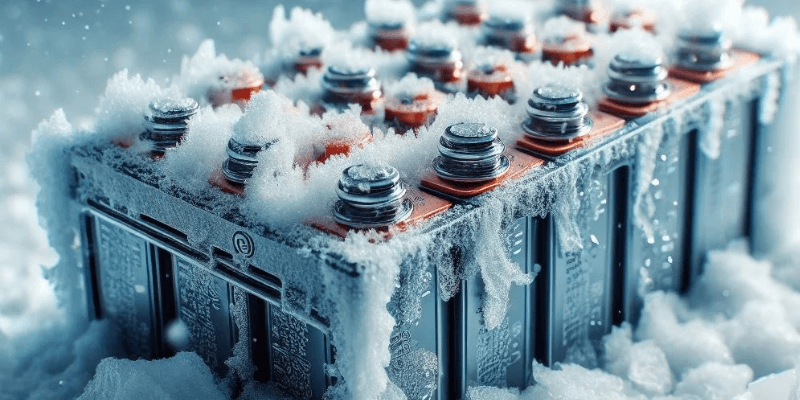Key Takeaways:
- Cold Weather Impact: Cold increases internal resistance and reduces battery capacity, but LFP batteries offer a wide safe temperature range.
- Lithium vs. Lead-Acid: Lithium batteries outperform lead-acid in cold, with better maintenance and cycle life.
- Charging Strategies: Special charging protocols are needed in cold weather to prevent capacity drop.
- Best Battery Choice: Opt for models like LiFePO4 designed for low temperatures.
- Storage and Maintenance: Keep batteries clean, warm them before use, store within the ideal temperature range, and maintain regular charging.
With the development of technology, lithium batteries have become the go-to power source for our daily lives, from smartphones to electric vehicles. However, how do these batteries perform in cold weather?
In this article, we will look into the performance of lithium batteries during winter and provides insights on how to maintain them for optimal performance.
The Impact of Cold Weather on Battery Performance
Battery Reactions at Low Temperatures
Cold weather increases a battery’s internal resistance and reduces its capacity, meaning the battery may not release or hold enough power in low temperatures.
However, LFP (Lithium Iron Phosphate) batteries are safe to use in a wide temperature range from -4°F to 140°F, making them ideal for various weather conditions.
Lithium vs. Lead-Acid Batteries
In cold weather, lithium batteries significantly outperform lead-acid batteries.
Lead-acid batteries discharge fast in the cold, while lithium batteries maintain their performance better.
In addition, the cycle life of lithium batteries far exceeds that of lead-acid batteries. The lithium deep cycle batteries can reach 3,000 to 5,000 cycles, while lead-acid batteries usually only have about 400 cycles.
Using Lithium Batteries in Cold Weather
Are Lithium Batteries Suitable for Cold Weather?
Although lithium batteries are suitable for cold weather use, it’s crucial to take care of charging strategies.
When charging at sub-freezing temperatures, lithium ions may not be effectively absorbed into the negative electrode, which can cause battery capacity to drop.
How to Charge Lithium Batteries in Cold Weather
Special protocols are required when charging in cold weather.
As temperatures drop, a more delicate charging process is necessary for batteries. Between 32°F and 14°F, the charging rate should not exceed 0.1C; between 14°F and -4°F, it should not exceed 0.05C.
The Best Battery Choice for Cold Weather
Choosing the right battery model and brand for cold weather is vital to ensuring proper operation of your device.
Some batteries, like certain lithium iron phosphate (LiFePO4) batteries, designed specifically for low-temperature environments, can provide better performance and longer service life.
Storing and Maintaining Lithium Batteries in Cold Weather
Keep Batteries Clean
Whether it’s summer or winter, it’s important to keep your battery clean.
For lead-acid batteries, cleaning with baking soda and water can prevent corrosion and extend battery life. Lithium batteries, on the other hand, require minimal maintenance.
Warm Up Batteries Before Use
Properly preheating batteries before bringing them from a cold environment into a warm one can enhance their efficiency and reduce potential damage.
Ideal Temperature for Batteries Storage
The ideal battery storage temperature range is 32°F to 80°F. Beyond this range, the battery’s capacity may be reduced, requiring more frequent charging.
Regular Charging to Maintain Battery Health
Due to the self-discharge characteristic of lithium-ion batteries, regular charging can prevent excessive discharge and maintain the battery’s health.
Conclusion
Cold weather does impact the performance and lifespan of lithium batteries, but these effects can be minimized with proper use and maintenance.
As battery technology continues to advance, we can be optimistic about the prospects of using lithium batteries in cold weather.
With the guide, you can better understand how to protect and use their lithium batteries in winter, ensuring that the devices remain at the best performance even in cold conditions.

